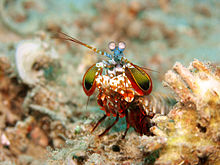Odontodactylus scyllarus
| Odontodactylus scyllarus | |
|---|---|

| |
| Scientific classification | |
| Kingdom: | |
| Phylum: | |
| Subphylum: | |
| Class: | |
| Order: | |
| Family: | |
| Genus: | |
| Species: | O. scyllarus
|
| Binomial name | |
| Odontodactylus scyllarus | |
The peacock mantis shrimp, Odontodactylus scyllarus, also known as the harlequin mantis shrimp or painted mantis shrimp, is a large mantis shrimp native to the Indo-Pacific from Guam to East Africa.[1]
Description

O. scyllarus is one of the larger, more colorful mantis shrimps commonly seen, ranging in size from 3 to 18 centimetres (1.2 to 7.1 in).[1] They are primarily green in color, with orange legs and leopard-like spots on the anterior carapace.[1]
Their ability to see circularly polarized light has led to studies to determine if the mechanisms by which their eyes operate can be replicated for use in reading CDs and similar optical information storage devices.[2][3]
Ecology
They are burrowers, constructing U-shaped holes in the loose substrate near the bases of coral reefs in water ranging from 3 to 40 metres (9.8 to 131.2 ft) deep.[1]
This mantis shrimp is a smasher, with club shaped raptorial appendages.[1] An active hunter, it prefers gastropods, crustaceans, and bivalves,[1] and will repeatedly smash its prey until it can gain access to the soft tissue for consumption. It is reported to have a "punch" of over 50 miles per hour (80 km/h). This is the fastest recorded punch of any living animal.
In aquaria
Peacocks are popular with aquarists for their bright colors and active behavior, but are not reef safe, as they will eat other tank occupants. They are therefore often kept as solitary creatures in acrylic tanks. Though they are burrowers in the wild, these animals will readily accept a suitably sized length of PVC pipe as a surrogate lair. They are active, intelligent, curious animals, capable of interacting with their keepers.
References
- ^ a b c d e f Roy Caldwell. "Species: Odontodactylus scyllarus". Roy's List of Stomatopods for the Aquarium. Retrieved July 18, 2006.
- ^ John Roach (June 27, 2011). "Shrimp eyes inspire optical tech". MSNBC. Retrieved June 28, 2011.
- ^ Yi-Jun Jen, Akhlesh Lakhtakia, Ching-Wei Yu, Chia-Feng Lin, Meng-Jie Lin, Shih-Hao Wang & Jyun-Rong Lai (2011). "Biologically inspired achromatic waveplates for visible light". Nature Communications. 2: 363. doi:10.1038/ncomms1358. PMID 21694711.
{{cite journal}}: CS1 maint: multiple names: authors list (link)
